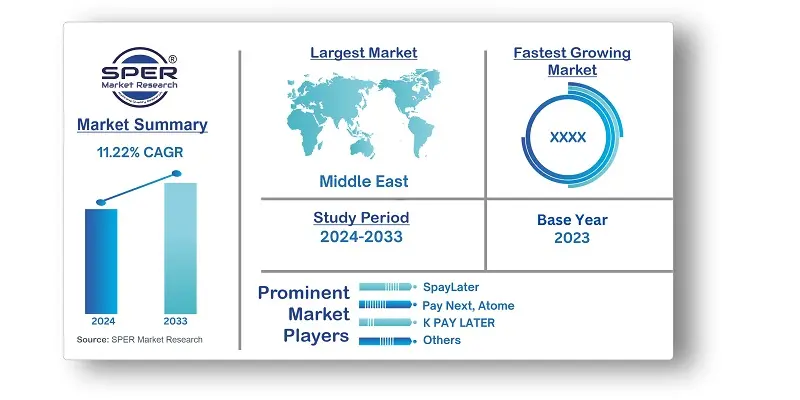
Thailand Buy Now Pay Later Market Growth, Size, Trends, Share, Revenue and Future Outlook
Thailand Buy Now Pay Later (BNPL) Market Size- By Channel, By Enterprise Type, By Category- Regional Outlook, Competitive Strategies and Segment Forecast to 2033
| Published: Mar-2024 | Report ID: IACT2448 | Pages: 1 - 102 | Formats*: |
| Category : Information & Communications Technology | |||


| Report Metric | Details |
| Market size available for years | 2020-2033 |
| Base year considered | 2023 |
| Forecast period | 2024-2033 |
| Segments covered | By Channel, By Enterprise Type, By Category |
| Regions covered | Eastern Region, Western Region, Southern Region, Northern Region |
| Companies Covered | SpayLater, Pay Next, Atome, K PAY LATER, Shop Now Pay Later. |
- Consumers
- E-Commerce Retailers
- Financial Institutions
- Government Agencies and Regulatory Bodies
- Industry Associations and Advocacy Groups
- Investors and Venture Capitalists
- Market Research Firms and Cosultants
| By Channel: |
|
| By Enterprise Type: |
|
| By Category: |
|
- Thailand Buy Now Pay Later Market Size (FY’2024-FY’2033)
- Overview of Thailand Buy Now Pay Later Market
- Segmentation of Thailand Buy Now Pay Later Market By Channel (Point of Sale, Online)
- Segmentation of Thailand Buy Now Pay Later Market By Enterprise Type (SMEs, Large Enterprises)
- Segmentation of Thailand Buy Now Pay Later Market By Category (Banking, Financial Services and Insurance, Consumer Electronics, Fashion & Garment, Healthcare, Retail, Media and Entertainment, Others)
- Expansion Analysis of Thailand Buy Now Pay Later Market
- Problems and Obstacles in Thailand Buy Now Pay Later Market
- Competitive Landscape in the Thailand Buy Now Pay Later Market
- Impact of COVID-19 and Demonetization on Thailand Buy Now Pay Later Market
- Details on Current Investment in Thailand Buy Now Pay Later Market
- Competitive Analysis of Thailand Buy Now Pay Later Market
- Prominent Players in the Thailand Buy Now Pay Later Market
- SWOT Analysis of Thailand Buy Now Pay Later Market
- Thailand Buy Now Pay Later Market Future Outlook and Projections (FY’2024-FY’2033)
- Recommendations from Analyst
1.1. Scope of the report1.2. Market segment analysis
2.1. Research data source2.1.1. Secondary Data2.1.2. Primary Data2.1.3. SPER’s internal database2.1.4. Premium insight from KOL’s2.2. Market size estimation2.2.1. Top-down and Bottom-up approach
2.3. Data triangulation
4.1. Driver, Restraint, Opportunity and Challenges analysis4.1.1. Drivers4.1.2. Restraints4.1.3. Opportunities4.1.4. Challenges4.2. COVID-19 Impacts of the Thailand Buy Now Pay Later Market
5.1. SWOT Analysis5.1.1. Strengths5.1.2. Weaknesses5.1.3. Opportunities5.1.4. Threats5.2. PESTEL Analysis5.2.1. Political Landscape5.2.2. Economic Landscape5.2.3. Social Landscape5.2.4. Technological Landscape5.2.5. Environmental Landscape5.2.6. Legal Landscape5.3. PORTER’s Five Forces5.3.1. Bargaining power of suppliers5.3.2. Bargaining power of buyers5.3.3. Threat of Substitute5.3.4. Threat of new entrant5.3.5. Competitive rivalry5.4. Heat Map Analysis
6.1. Thailand Buy Now Pay Later Market Manufacturing Base Distribution, Sales Area, Product Type6.2. Mergers & Acquisitions, Partnerships, Product Launch, and Collaboration in Thailand Buy Now Pay Later Market
7.1. Thailand Buy Now Pay Later Market Value Share and Forecast, By Channel, 2024-20337.2. Point of Sale
7.3. Online
8.1. Thailand Buy Now Pay Later Market Value Share and Forecast, By Enterprise Type, 2024-20338.2. SMEs8.3. Large Enterprises
9.1. Thailand Buy Now Pay Later Market Value Share and Forecast, By Category, 2024-20339.2. Banking, Financial Services and Insurance (BFSI)9.3. Consumer Electronics9.4. Fashion & Garment9.5. Healthcare9.6. Retail9.7. Media and Entertainment
9.8. Others
10.1. Thailand Buy Now Pay Later Market Size and Market Share
11.1. Thailand Buy Now Pay Later Market Size and Market Share By Channel (2020-2026)11.2. Thailand Buy Now Pay Later Market Size and Market Share By Channel (2027-2033)
12.1. Thailand Buy Now Pay Later Market Size and Market Share By Enterprise Type (2020-2026)12.2. Thailand Buy Now Pay Later Market Size and Market Share By Enterprise Type (2027-2033)
13.1. Thailand Buy Now Pay Later Market Size and Market Share By Category (2020-2026)13.2. Thailand Buy Now Pay Later Market Size and Market Share By Category (2027-2033)
14.1. Thailand Buy Now Pay Later Market Size and Market Share By Region (2020-2026)14.2. Thailand Buy Now Pay Later Market Size and Market Share By Region (2027-2033)14.3. Eastern Region14.4. Northern Region14.5. Western Region14.6. Southern Region
15.1. SpayLater15.1.1. Company details15.1.2. Financial outlook15.1.3. Product summary15.1.4. Recent developments15.2. Pay Next15.2.1. Company details15.2.2. Financial outlook15.2.3. Product summary15.2.4. Recent developments15.3. Atome15.3.1. Company details15.3.2. Financial outlook15.3.3. Product summary15.3.4. Recent developments15.4. K PAY LATER15.4.1. Company details15.4.2. Financial outlook15.4.3. Product summary15.4.4. Recent developments15.5. Shop Now Pay Later15.5.1. Company details15.5.2. Financial outlook15.5.3. Product summary15.5.4. Recent developments15.6. Others
SPER Market Research’s methodology uses great emphasis on primary research to ensure that the market intelligence insights are up to date, reliable and accurate. Primary interviews are done with players involved in each phase of a supply chain to analyze the market forecasting. The secondary research method is used to help you fully understand how the future markets and the spending patterns look likes.
The report is based on in-depth qualitative and quantitative analysis of the Product Market. The quantitative analysis involves the application of various projection and sampling techniques. The qualitative analysis involves primary interviews, surveys, and vendor briefings. The data gathered as a result of these processes are validated through experts opinion. Our research methodology entails an ideal mixture of primary and secondary initiatives.



Frequently Asked Questions About This Report
PLACE AN ORDER
Year End Discount
Sample Report
Pre-Purchase Inquiry
NEED CUSTOMIZATION?
Request CustomizationCALL OR EMAIL US
100% Secure Payment






Related Reports
Our Global Clients
Our data-driven insights have influenced the strategy of 200+ reputed companies across the globe.




















